Belper
Belper, Derbyshire. Fri-Sun 27-29 May 2011

The Derwent at Belper - Fuji X100
more pictures
I'd gone up to Belper for my grand-daughter's first birthday party, so most
of what I took over the weekend was family snaps (family & friends e-mail
me for link.) But I also spent some time trying out the Fuji Finepix X100,
including taking a couple of panoramas and some other pictures during a couple
of walks around the area, as well as a few on the journey via Birmingham and
Derby, although most of the pictures here were taken on a Nikon D300. Despite
its rather smaller size the FX100 has a sensor the same dimensions and picture
quality was very similar, though of course the Nikon is much more versatile.
more pictures
Other Protests Against Obama
Buckingham Palace, London. Tuesday 24 May 2011
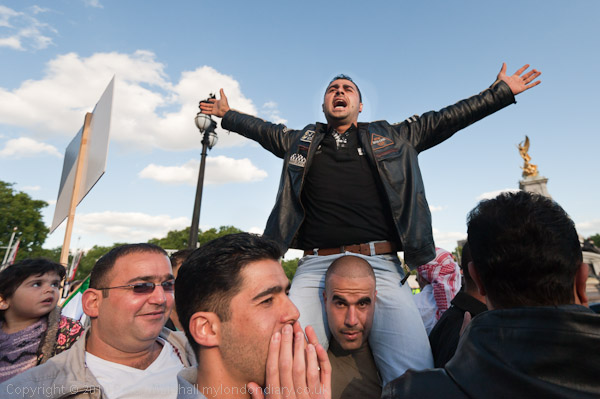
Syrians call for support for their right to protest in Syria
more pictures
A bewildering variety of protesters turned up at Buckingham Palace for Obama's visit, arriving shortly after those calling for the release of Londoner Shaker Aamer from Guantanamo. Most of the others either wanted an end to US interference in Libya and other Arab nations, or for support for oppostion movements in those countries.
Other groups included Stop the War who were calling for an end to the war in Afghanistan and the bombing in Libya. They brought with them a cowboy with two six-shooters which he aimed at targets scattered around the Middle East on a large map of the world.
A large group of Libyan protesters with green flags and scarves supporting Gadaffi were also calling for an end to NATO attacks on Libya which are killing civilians, and the embargoes which are making life hard for the people of the country.
At each end of the protesters were two groups of Syrians, both with Syrian flags, one against the dictator president Assad responsible for the army firing on and killing peaceful demonstrators in Syrian and the other group with large professionally produced placards and posters supporting him.
Another large group were Bahrainis, protesting about the use of Saudi troops against protesters there. At times the groups were rather mixed together, and with many of the placards only in Arabic it was hard to tell who was who.
There were also protesters from Iraq and I think a few from Iran, along with several indiduals pleading particular causes, including Peter Tatchell with a placard calling for the release of Wikileaks whistleblower Bradley Manning who exposed US war crimes and anti-gun campaigner and former boxer King David.
I didn't see Obama, although I imagine he was somewhere in the large motorcade
that came past the demonstrations and may have noticed that something was
happening, but the media were out in force for the event and doubtless he
and his advisers, along with the UK government will have seen some of them
on TV and in the press.
more pictures
Obama Told 'Release Shaker Aamer Now!'
Buckingham Palace, London. Tuesday 24 May 2011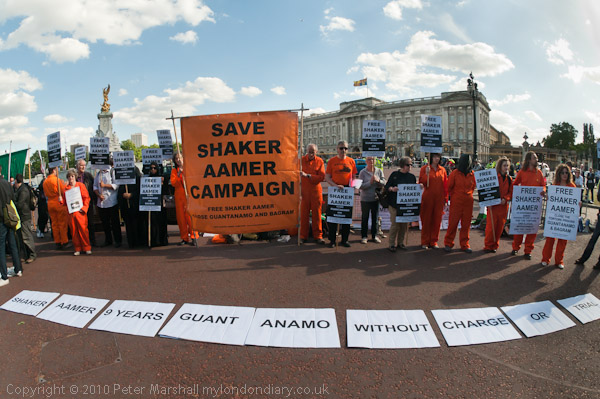
'Shaker Aamer 9 Years Guantanamo Without Charge Or Trial'
more pictures
A bewildering variety of protesters turned up at Buckingham Palace on Tuesday
evening for Obama's visit. First to arrive were the Save Shaker Aamer and
London Guantanamo campaigns with around a dozen protesters in orange jumpsuits,
several with black hoods and one man in chains wearing an Obama mask. They
urged Obama to carry out his earlier promise to close down Guantanamo, and
in particular to send home Londoner Shaker Aamer, held for 9 years without
charge or trial. His family in Battersea includes one child born after he
was detained who he has yet to see.
more pictures
Spanish Revolution Camp in London
Belgrave Square, London. Saturday 21 May 2011
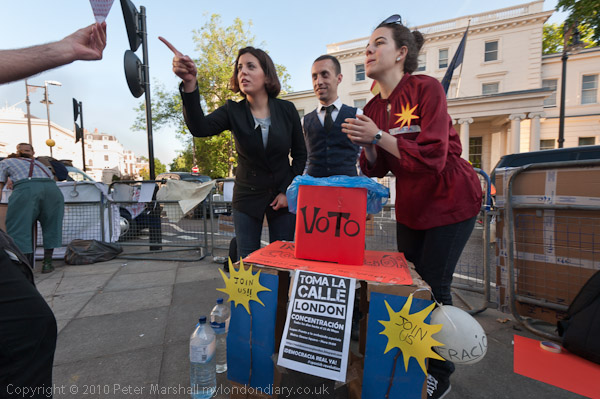
An opportunity to 'vote' opposite the Spanish Embassy
more pictures
Young Spanish people in London have been protesting outside the Spanish Embassy, some camping there since Wednesday, in solidarity with those in Madrid to acheive 'a real democracy' .
Following the occupation by protesters of the Puerta del Sol in Madrid since 15 May, groups of angry young Spaniards have set up camps in more the 50 other cities around the world, including one oppostive the London embassy in Belgrave Square. Like the camp in Madrid, the London camp is well organised, with a desk labelled logistics and areas for dumping sleeping gear and donating food and drink.
The "Spanish Revolution" began with a march against the mass unemployment, austerity measures and political corruption. They are calling for a "True Democracy" with "a society that prioritises people over economic interest" and reject both the Socialist government and the right wing which is expected to do well in the elections on Sunday.
When I called in on Saturday lunchtime there were only around 50-100 people present, taking part in discussions and art workshops, but during the afternoon more and more people arrived, and by the time I left around 7pm there were perhaps 500 present, with more and more arriving to join in.
There were barriers around a large traffic island in the square opposite the embassy, and it was here that most of the activity was taking place, with placards and banners covering most of the barriers. Traffic was still flowing freely around the square, including along the roadway between this island and the centre of the square where the food and logistics were. At the logistics disk they were writing name labels for the protesters and giving out information about what was happening and vital details such as the location and opening times of the nearest toilets at Victoria and Hyde Park corner.
When I returned in the early evening, a mock election was taking place, with
people posting messages into a ballot box rather than votes. Later these were
read out revealing some of the hopes that people have for their protest. Later
there was much chanting of slogans and dancing and banging of pans in protest.
more pictures
Picket Against Former Colombian President Uribe
Sussex Terrace, Regents Park, London. Saturday 21 May 2011
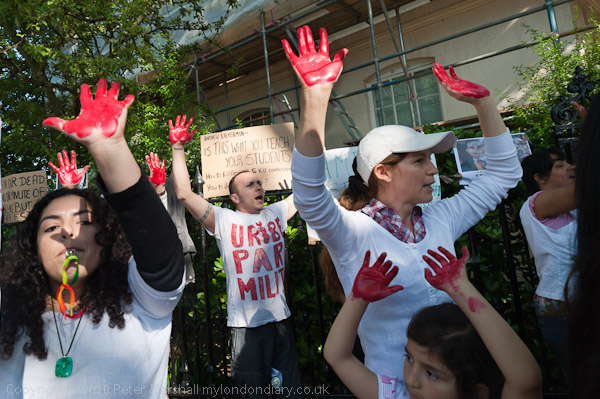
Red hands raised in protest against former Colombian President Uribe Vélez
more pictures
The Colombia Solidarity Campaign and Polo Democratico UK organised a picket of the London Business School, where former Colombian President Uribe Vélez was speaking.
Álvaro Uribe Vélez was president of Colombia from 2002 to 2010, elected on a popular vote and remaining high in the opinion polls largely because of a determined campaign against the major armed guerrilla groups FARC (who killed his father during a kidnap attempt in 1983) and ELN. He tried but failed to get the Colombian constitution changed to allow him to serve a further term in office.
Uribe claims that the success of his presidency was based on three aspects, security, social cohesion and gaining the trust of international investors. Although he has considerable support among western institutions, Colombian critics are call him a murderer and ask for his trial on charges of crimes against humanity, corruption and human rights violation.
In a previous role as a departmental governor, Uribe had supported the setting up of many private security services which became notorious for their human rights violations and many in them joined up to paramilitary organisations when these were restricted by the Constitutional Court. Uribe was later responsible for granting roughly 90% of the members of these groups an amnesty over their human rights violations. During his presidency there were more than 3000 extra-judicial killings by the official state security forces, with the secret police tapping the phones of journalists, politicians and the judiciary and sujpplying lists of trade unionists to be assassinated. One mass grave discovered by chance was next to an army base and was found to contain two thousand bodies, and there have been many 'disappearances.'
Politically their were many scandals among Uribe's associates and friends, and around a hundred congress seats are occupied by paramilitary front men, mainly Uribe supporters.
During his 8 years of rule there was an increasing gap between rich and poor, particularly because of the forced displacement of 2.65 million people, including many rural indigenous people, poor farmers and Afro-Colombians. Most of them now live in cardboard shanty towns on the edges of the larger cities and have been abandoned by the state except for occasional evictions by the riot police and assassinations.
The big success of his rule, at least in Western eyes, is in the high profit levels made by multinational corporations, particularly in mining of coal, oil and gas, where mineral claims increased by 7.5 times. Companies including BP have benefitted from the activities of paramilitary groups who discourage trade union and community organisation by a programme of assassinations and 'disappearances'.
While opposition groups in Colombia call for Uribe to be put on trial for his crimes, the huge profits he has allowed to be taken out of the country have endeared him to the multinationals and Western leaders - and his invitations to speak at both the London Business School where this demonstration took place and at the LSE later this week reflect this.
A little over 50 people turned up on Saturday outside the London Business School in Regent's Park where Uribe was speaking, although more were still arriving as I left around 90 minutes after the protest was due to start. The noise that they were making with shouting and various musical (and not so musical) instruments was pretty deafening, and must have been clearly audible where Uribe was speaking.
Many of the protesters covered their hands in red paint as a symbol of the guilt of Uribe, and some of the pictures of him on the posters had added devil's horns in red, as well as in some cases a small Hitler moustache. Some repeated the allegations of his connection with the Medellin drugs Cartel in the 1980s and 90s made in a then classified U.S. Defense Intelligence Agency report in 1991, which described him as "dedicated to collaboration with the Medellín cartel at high government levels" and labelled him a "narco-trafficker." Other protesters carried placards with the names and portraits of some of those who have disappeared. Another banner named Uribe as Colombia's #1 Murderer - accusing him of the deaths of 565 trade unionists and 1,400 indienous people.
Several of those coming late to the event stopped to talk to the protesters on their way in, and others wandered across the car park inside the event during a tea break to see what was happening, with some clearly indicating their support. One or two cars drove by without stopping, one possibly containing Uribe.
Much of the chanting was directed specifically at the London Business School and its director Andrew Liekerman, who were accused of thinking only about profits and not entertaining any ethical considerations. As one poster asked, 'Is this what you teach your students? How to Kill People, To Kill communities? How to dissapear people?'
I left around 15 minutes after Uribe's talk had been due to start, and the
protest was still gaining in numbers and volume.
more pictures
FRFI Speak Out Against the Cuts
Angel, Islington, London. Saturday 21 May 2011
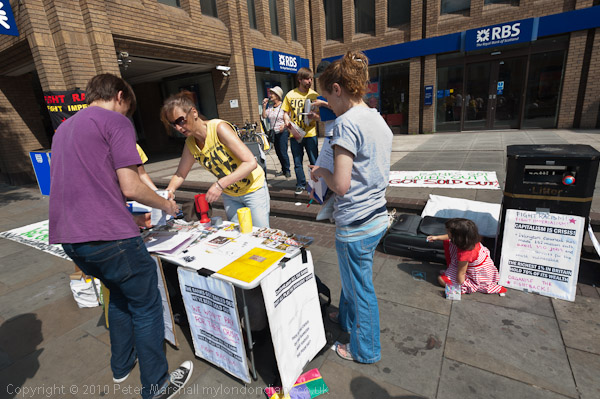
The bookstall, banners and speaker outside the Angel RBS
more pictures
Fight Racism, Fight Imperialism held a street rally outside the Angel tube, campaigning against Islington Council’s cuts to vital public services. Islington is a London inner-city borough with more than its share of problems caused by poverty and unemployment, and cuts in public services there will cause real hardship to many.
Fight Racism! Fight Imperialism is the Revolutionary Communist Group (RCG) who believe that the only way that human society will progress is through a working class led revolution that will destroy capitalism and replace it by a planned socialist economy that rejects imperialism and respects the environment and democratic and human rights, a "society in which people cooperate in order to meet their needs rather than serve the dictates of private profits; a society enabling the full development of every individual rather than privilege for a few."
While recognising that the cuts result from the measures imposed by the Con-Dem coalition government they insist that local councils - such as the Labour Islington Council - should have fought against the cuts and if necessary resigned rather than implement them.
Like many of us they compare rewards given to bankers, who after being being bailed out by huge government subsidies went on to award themselves bonuses of over £7 billion at the turn of the year with the massive cuts affecting the rest of us - with Islington Council cutting £52 million in public services which mainly effect the poorest and most vulnerable. They say "This is the crisis of the bankers - why should the poor pay?" and "The banks got bailed out - we've been sold out."
They also state that "our" government doesn't act in the interests of the nation as a whole but to protect the interests of a small minority. We live in a country where the richest 1% hold 70% of the wealth of the nation and in the current cabinet 23 out of 29 members are millionaires. As they ask "Whose interests are they serving?"
The rally went on for several hours on the pavement with many people passing
by, some stopping for a few minutes to listen to the speakers, talking with
those handing out leaflets, signing the petition or looking at the literature
stall.
more pictures
BDS Picket Tesco Over Illegal Israeli Goods
Bedford St, Covent Garden, London. Saturday 21 May 2011
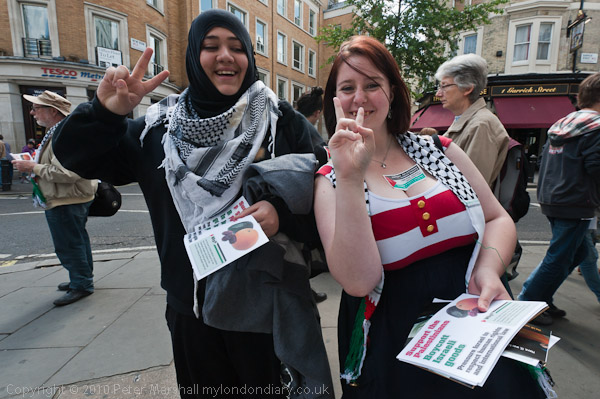
Leafletting opposite the Tesco Metro
more pictures
Activists from the London Boycott, Divestment and Sanctions (BDS) campaign handed out leaflets outside Ahava and Tesco shops in Covent Garden calling for a boycott of products grown in illegal settlements on Palestinian land.
London BDS describes itself as "a grassroots coalition of human-rights activists who proactively campaign for a free and independent Palestine" and has been organising regular fortnightly protests at the Ahava shop on Monmouth Street since 10 January 2009.
Ahava beauty products are made using mud excavated from the shore in the occupied northern area of the Dead Sea under a licence issued by the Israeli Civil Administration in 2004 in violation of the international laws governing occupied territories.
On Saturday their protests started at Ahava and then went on to a picket outside Tesco in Bedford Street, which sells fruit, vegetables and herbs supplied by Carmel Agrexco which markets 70% of the agricultural produce from the illegal Israeli settlements on Palestinian land, misleading consumers by labelling these as 'made in Israel.' Palestinian organisations including farmers' unions, agricultural organisations and other bodies have called for a complete boycott of Carmel-Agrexco.
The protesters, who included both Jews and Muslims, handed out leaflets explaining
the position and giving some of the logos and trademarks that would enable
shoppers to identify the goods produced on these stolen lands. The entirely
peaceful protest was watched from inside the store throughout the time I was
there by a man wearing a white t-shirt with a Star of David logo and the words
'We Believe In Israel.' Many of those calling for justice for Palestine
and involved in the Boycott Israeli Goods campaign are also Jewish and supporters
of Israel, but are ashamed of the way that this country behaves towards the
Palestinians.
more pictures
Syrians Ask For Support
Downing St, London. Tuesday 17 May 2011
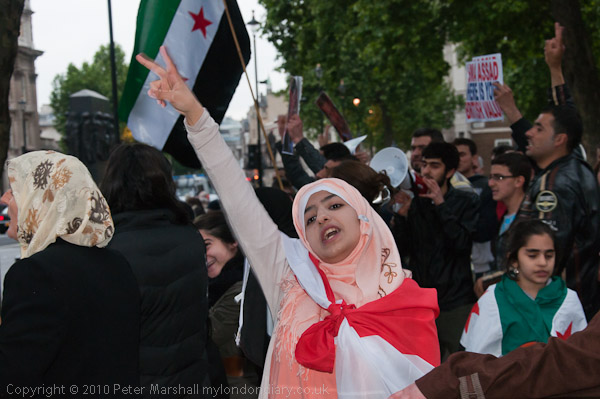
A young woman give a victory sign
more pictures
Syrians supporting the 'People's Revolution' in their country called for support from the British people and government to support their demands for reform and to stop the bloodshed in Syria.
A large group of Syrians, men, women and children from various groups including Kurds from Northern Syria, protested opposite Downing Street on Tuesday evening, calling for support from David Cameron and the British people for the Syrian people. Since the demonstrations for political and economic freedom and an end to the tyranny and bloodshed of the Assad regime started on March 15th, more than 800 innocent protesters have been killed, over 2000 injured and many more detained.
The Syrian regime has responded to peaceful protest with bullets and tanks and by detaining and torturing protesters. As a large NHS demonstration made its way past a protester told me "That is what we want, that's all we want to do, to be able to protest peacefully."
A large hand-drawn placard drew attention to the series of massacres by the Assad family, starting with the 40,000 killed at Hama in 1982, and claimed that since that date 17,000 people have gone missing in Syria.
The protesters asked people to sign their petition to the British government
for support, and to sign the Amnesty International petition calling for an
end to the bloodshed, as well as putting pressure on their MPs.
more pictures
Keep The NHS Public
UCH Euston Road to Whitehall, London. Tuesday 17 May 2011
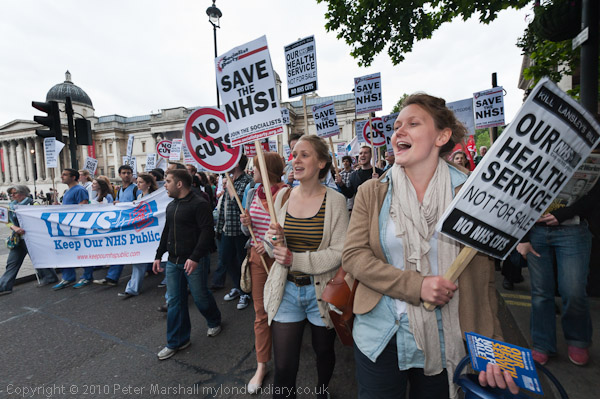
The march comes through Trafalgar Square
more pictures
Over a thousand people, including many medical professionals and medical students, marched through London to show their opposition to government reforms which threatens jobs and many feel would destroy the NHS.
This was the second large march in London aimed at saving the NHS and killing Andrew Lansley's Health & Social Care Bill. Although many feel that some reform of the NHS is needed, many view the current proposals as an attempt to break up the NHS and hand it over to private healthcare services. Already the public outcry, particularly from the medical profession, has forced the government to delay the bill and consult further, and this march was intended to increase the pressure for changes in the bill to save the health service as a public service. The speakers and marchers want to preserve a health service that provides treatment free when we need it; as one medical student put it, he was born under the National Health Service and wants to work and to die under it. Front line services in the NHS are already under threat from cuts, with perhaps as many as 50,000 jobs under threat.
Marchers assembled at University College Hospital on Euston Road, where there were a number of speeches from speakers representing medical organisations, trade unions and local MPs Jeremy Corbyn and Frank Dobson.
Eventually the march set off, making its way down Gower St and Shaftesbury Avenue. When it reached Cambridge Circus there was a 'die-in' by students and others in medical garb in the centre of the road, but after a couple of minutes everyone got up and the march moved on. The same happened at Downing St, but the protesters soon got up and moved on to the pavement in front of the Department of Health at Richmond House a few yards down the road.
A group of six protesters staged a short sit-in on the roadway in front of Downing St, but were soon approached by police and decided to get up and move away rather than risk arrrest.
At Richmond House some fake blood was thrown on to the pavement in a photo-opportunity,
and there were some further short speeches before the protest dispersed. It
had been throughout a peaceful if noisy protest, and the police had virtually
nothing to do other than manage the traffic.
more pictures
For and Against Libyan Bombing
Downing St, London. Monday 16 May 2011
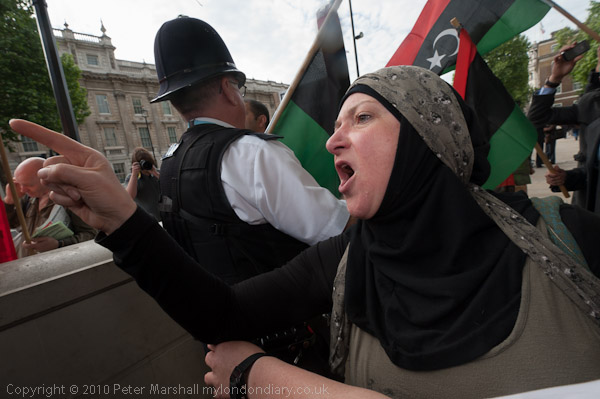
Police restrain Libyan opposition supporter shouting at the Workers Revolutionary
Party Young Socialists
more pictures
A protest against the bombing of Libya organised by Stop the War to coincide with the parliamentary debate was supported by pro-Gaddafi Libyans and opposed by supporters of the Libyan opposition.
A little over a hundred protesters turned up opposite Downing St in the early evening for a protest against the NATO bombing of Libya which had been called by Stop the War and supported by other groups including CND. Protesting with them were a number of pro-Gadaffi Libyans, some waving the all-green Libyan flag, and around there were around fifty of them who remained to continue the protest for a short time after the Stop the War protesters went home.
There were a number of speakers at the protest including Bruce Kent, all opposed to the intervention and calling for an end to the attacks on Libya. They were able to point to the escalation that has already occurred and the dangers of a continuing scaling up of the conflict.
Shortly after the rally started, a small group of Libyan opposition supporters arrived and set up a protest around twenty or thirty yards further up the street, where a line of police soon moved in to make sure they did not get closer. It was a noisy protest, with the Libyans shouting out that Stop the War were supporting the oppressive Gaddafi regime, and that 42 years of his rule was enough and that he had to go.
Close to them were an even smaller group around the Workers Revolutionary Party Young Socialist banner who were calling for everyone to support Gaddafi in his fight against the opposition who they claimed were taking part in an imperialist effort to replace him. After a while the police moved this group further away from the Libyan opposition, although there had been no actual trouble, just some rather loud and repetitive shouting between the two groups. One young man argued very loudly with the police when they were asked to move.
It seemed most unlikely to those of us watching that the tensions between the various groups would ever lead to more than angry shouting, but apparently the police thought otherwise, and soon reinforcements arrived and brought barriers to put around both the Stop the War protest and the Libyan opposition, who were also moved a few yards further away.
By this time the speeches at the Stop the War rally had finished, but a megaphone was still being used to lead the chanting of slogans. Officers at this point warned the man speaking through it that he was not allowed to use a megaphone, I think under the terms of the now discredited SOCPA legislation on demonstrations in the vicinity of parliament. It seemed a surprising move, particularly as the Libyans a few yards up the road continued to use their megaphone.
Around 6.40 the pro-Gaddafi Libyans decided to leave and made their way as
a group towards Bridge Street, where they put away their placards, green flags
and scarves and some as least dispersed. The Libyan opposition supporters
jeered at them as they left, and then they too packed up. Although there had
been no violence or trouble at the protest, as my bus took me away from the
area I saw a small scuffle taking place between police and a couple of the
Libyans who had been at the protest.
more pictures
A Country Weekend
Unstone and Bolsover, Derbyshire. 14-15 May 2011

Derbyshire countryside at Unstone
more pictures
I spent the weekend at Unstone Grange in Derbyshire, not far from Sheffield, a large Victorian house (still with some rather Victorian plumbing) owned by a trust which manages it as a centre for 'personal creative growth', "a beautiful place where people can come together to explore and grow in their understanding of life, themselves and others." It also very much embraces sustainability and is home to an organic gardening project in its nearly 5 acres. Among other things I was there for a party together with two old friends with whom I share the same birthday.
I got up half an hour before breakfast on both Saturday and Sunday and took a couple of short walks around the garden and the nearby village, with a camera around my neck, and on Saturday afternoon while most of the nation was watching some football match the three of us together with a few others visited Bolsover Castle, an impressive site run by English Heritage.
Although it sits impressively on a hilltop on the site of a medieval fortress, it was built as a kind of luxury venue by and for the super-rich of the seventeenth century, a sham castle with a 'toy keep', the Little Castle, full of luxurious staterooms with elegant fireplaces, murals and painted ceilings. Started by Charles Cavendish who acquired the site in 1608, it was completed by one of his sons, William Cavendish, Marquis of Newcastle. The money for it all was inherited from Charles's mother, Bess of Hardwick, a woman from a wealthy background who made herself the richest woman in the Elizabethan England after the Queen by outliving and inheriting from four wealthy husbands. Next to the Little Castle they built the huge long rooms of the Terrace Range, a stately home on a similar scale to Versailles running along the edge of the hill, its rugged stone walls now long open to the skies as a dramatic ruin (and one in which the younger members of our party escaped from their mother and had a fine game of hide and seek - strictly against the rules.)
Behind this is another range of buildings which retain their roofs, one of which was built as the Riding House, and is still an indoor riding school with a sand covered floor. Cavendish was regarded as the leading horseman in Europe and was a leading figure in manège, the precursor of dressage, and published his 'La Methode Nouvelle et Invention Extraordinaire de Dresser les Chevaux', apparently still a valued textbook on the subject, in 1657.
Cavendish had a bad civil war as a Royalist, refused entry to Hull, blamed unfairly for the royalist defeat at Marston Moor, and then went into exile and had his property - including the castle - seized. After the restoration he managed to get most of his property back and was upped from Marquis to Duke of Newcastle upon Tyne (quite a title collector, he was also Viscount Mansfield, Baron Cavendish of Bolsover and Earl of Ogle and doubtless a few more.)
Bolsover Castle is administered by English Heritage who
generally encourage visitors to their sites to take their own photographs
for personal use and non-commercial sharing, and emphasise that those taking
the pictures retain the copyright, while requiring those who want to produce
images for commercial purposes to pay a fee. It seems a reasonable policy
and in keeping with it, unlike most other images on this site, the pictures
taken in the grounds and buildings of Bolsover Castle shown here are not available
for sale or licence.
more pictures
Hardest Hit March Against Cuts
Westminster, London. Wednesday 11 May 2011
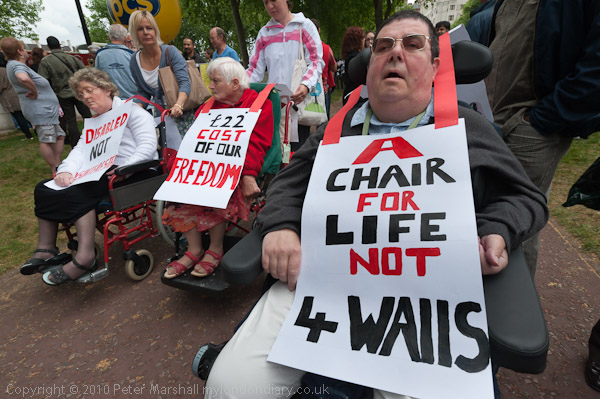
A Chair for Life Not 4 Walls
more pictures
Around 10,000 people, many in wheelchairs, marched through London in the Hardest Hit march, calling to an end to harassment and benefit cuts for the disabled.
The protest was supported by a huge range of charities representing and supporting the physically and mentally disabled, alongside major unions including the PCS, UCU and Unite. They called for an end to cuts in benefits for the disabled, and in particular for an end to the discredited and iniquitous testing regime adminstered by Atos Healthcare, which has replaced proper medical tests by a computer-based system that often ignores the actual needs of those being assessed, and has au unacceptably high error rate, with a majority of appeals against its assesments suceeding.
The often ludicrous decisions of Atos assessments have also been used by the government, and with their encouragement by the press to justify attacks on those drawing disablement benefits as 'scroungers'. While many would agree that we need an overhaul of the benefits system, and most that where suitable employment can be found within the capabilities of the person concerned this would be to their benefit, the changes introduced by the previous government, along with the cuts of the current coalition have been disastrous. Among the banners on the march was one for Remploy, an organisation providing suitable work for many disabled people, which has been savagely pruned, along with many other positive projects aimed as helping the disabled.
The government is making cuts in the Equality and Human Rights commission that helps to protect the disabled against discrimination, and disabled people rely much more than the rest of us on local authority support services and other public services and so are suffering more from the cuts in these.
Among those leading the march which went past the Houses of Parliament was Sally Bercow, the wife of the Speaker of the Commons, and with her was actress and activist Jane Asher, president of three of the organisations involved in the march: Arthritis Care, National Autistic Society and Parkinson's UK.
Among the many placards, one that stood out carried a part of its message in Braille; 'We're being ........ by the government!' and I was told the dots meant 'screwed'.
After the march ended many of those taking part went back to Parliament to
lobby their MPs and call for better treatment for the disabled.
more pictures
Southbank Centre
London. Monday 9 May 2011
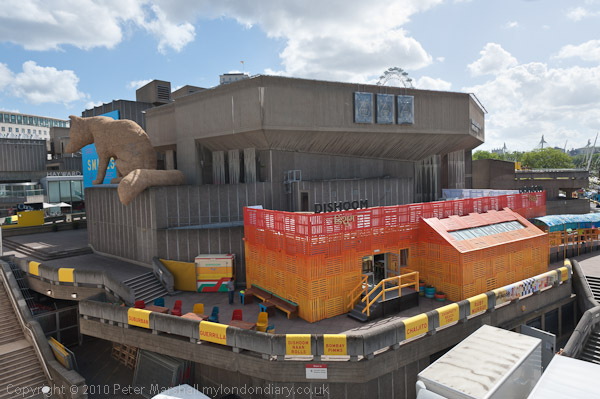 Urban
Fox sitting on the edge of the gallery
Urban
Fox sitting on the edge of the gallery
more pictures
In 1951 the Festival of Britain took place on the south bank of the Thames
and millions came to it. Then they knocked it all down (except for the Royal
Festival Hall) and put up some new buildings. Including a large arts centre.
more pictures
Disabled Protest Calls Atos Killers
Atos Healthcare, Triton Square, London. Monday 9 May 2011
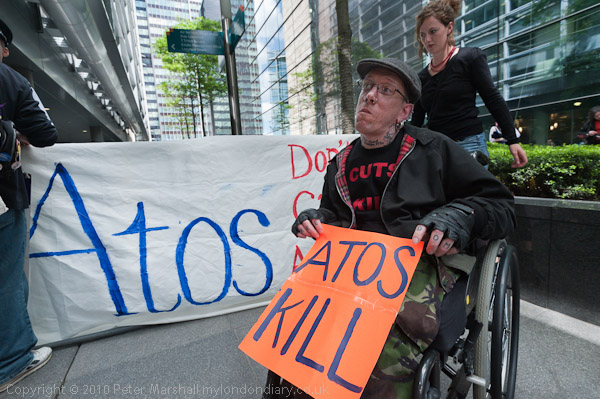
Atos Don't Care A Toss - banner and protesters outside Atos
more pictures
Around a hundred protesters, including many with disabilities, protested outside Atos Healthcare, whose tests they claim deny many severely disabled their essential benefits.
The government are replacing Incapacity Benefit by Employment and Support Allowance (ESA), and have contracted a private company, Atos Healthcare to carry out tests on all claiming it to assess whether they are capable of working. The tests Atos uses are computer based and are carried out by health workers, many of whom are not qualified doctors, and who are only allowed a short time to reach a decisions on what are often complex cases.
Roughly seven out of ten of those tested are refused ESA and passed as fit to work when in many cases they are clearly incapable of carrying out any normal duties. A report by Citizen's Advice concluded that "Doctors produce inaccurate reports ... reporting incorrectly what the claimant has said about their own conditions and taking their answers out of context" and stating that they "pay more attention to the computer than the client." Other groups including the Child Poverty Action Group and a report commissioned by the government itself have also found the conduct of the tests by Atos unsatisfactory, but despite this their contract has been renewed.
One of the problems is that the computer system doesn't allow the actual answers given by claimants to be recorded, instead it relies on those carrying them out to choose one of a list of stock phrases which they feel represents what the person said. Often they chose one that doesn't properly reflect the situation of the claimant, and which may result in them being incorrectly judged as able to work when in fact they need a very high level of care.
The tests particularly discriminate against the mentally ill and those who have intermittent or fluctuating conditions. Many of those who are refused ESA appeal against the decision, and between 40 and 70% of these appeals are upheld, showing an unacceptable standard of testing. And many of those who have successfully appealed have have been again turned down by Atos on a subsequent test.
Many of those who spoke did so from wheelchairs and talked about the problems that they had after being refused ESA. One woman talked about her brother, who had killed himself after having been refused benefits, one of several known cases where this has happened.
Atos have a clear conflict of interest in carrying out these tests in that they also have a government contract to carry out compulsory work programmes and get paid for getting people off benefits and back to work.
The changes in the benefit system were introduced by the last Labour government, but are being pushed through at a time when the Con-Dem coalition is making huge cuts to pay for the billions spent in bailing out bankers. It is simply easier to target the disabled than to tackle problems such as the huge tax avoidance by corporations and rich individuals.
The protest was a part of a 'National Week of Action Against Atos Origin'
organised by disability activists, claimant groups and anti-cuts campaigners
and supported by over 50 groups around the country. Among those present at
this action were Disabled People Against Cuts, London Coalition Against
Poverty, Mad Pride, Right to Work, Winvisible and Solidarity Federation.
Many disabled activists are unable to get to demonstrations such as these,
or fear to do so as it might prejudice their capability to work assessments,
and are instead taking part in on-line protests as a part of the 'Armchair
Army.'
more pictures
Iranians On Hunger Strike Against Deportation
Westminster, London. Friday 6 May 2011
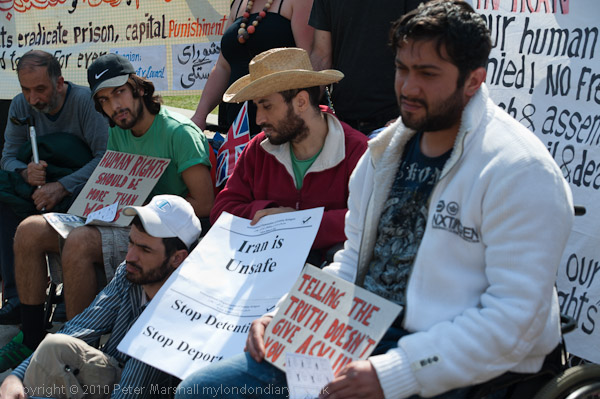
The hunger strikers face torture and death if sent back
to Iran
more pictures
Six young men refused asylum in the UK and threatened with deportation to Iran where they face torture and death have now been on a hunger strike for a month. They took part in a protest opposite Parliament and at the Home Office today.
The six men, one only 17, were arrested,tortured, beaten and one was raped for taking part in the anti-regime protests by the Iranian Green Movement in 2009. One of them who spoke for the others on College Green opposite the Houses of Parliament asked the just under a hundred supporters present "Who in this country, which of you can say they have been tortured without cease for 12 days?"
On arriving in the UK and claiming political asylum, there claims were met with a wall of disbelief by Borders Agency officials, who increasingly summarily dismiss the large majority of asylum applications, using unfair assessments and so-called 'credibility' tests, often completely disregarding the medical and other evidence. Political feeling stirred by a racist press has stoked a "culture of disbelief" under this and the previous government; although the UK still pays lip-service to human rights, its actions all too often show a blatant lack of regard for them, with ministers closing their eyes to the human consequences of their policies and pressuring the Borders Agency to cut down the numbers whatever the cost in lives when asylum seekers are returned to unsafe countries such as Iran.
Three of the men on hunger strike have sewn up their lips with nylon fishing line; a large banner at the demonstration read "Our Closed Lips Respond to Your Closed Eyes."
The Islamic regime in Iran is notorious and in 2010 executed more than 500 people, with over 300 executed in secret in Vakilabad Prison, and this year the executions are reported to have increased, with one every 9 hours in January. At least 13 people are known to have been executed for taking part in the 2009 demonstrations. Severe beatings, sleep deprivation and threats of harm to family members appear to have been used routinely on protesters, and at least four are known to have died as a result of the injuries sustained during torture. Since 2005 Iran has refused all the many requests for visits by the UN Special Rapporteurs on human rights.
Six Iranians refused asylum, Keywan Bahari, Kiarash Bahari, Ahmad Sadeghipour, Morteza Bayat, Mahyar Meyari and Mehran Meyari, began a hunger strike on 5 April, at the Amnesty International headquarters in London, refusing to eat or drink anything but water.
All one of the hunger strikers had to come to the protest in wheelchairs, although some could still walk a little with assistance; they were in obvious distress, but determined to continue their protest. After a short rally on College Green, ignored by the media crews reporting on yesterday's elections, they continued to the Home Office led by a bicycle sound system and accompanied by a small samba band.
To my surprise they did not protest outside the main entrance to the Home Office in Marsham St, but continued past it to a staff entrance in Horseferry Road, which is a rather busier route. Three police arrived, and two of them went into the entrance where they checked people going into the building, while another watched outside. In the hour or so I was there there were a few short speeches, and those present were urged to sign the online petition and to write letters to MPs and others urging that these men be allowed to stay.
Maria Gallastegui from the Parliament Square Peace Strike had come along with the protesters, and started a petition on a long roll of paper that she will take to Downing St on Monday.
The protest was suported by various groups including The International Organisation of Iranian Refugees (IOIR), No Borders and the Movement For Justice. In an open letter to the Home Office, the IOIR point out that Iran is an unsafe country where sending back asylum seekers would be denying them their most basic right, the right to live.
The letter also states:
"Many asylum seekers during their stay in this country have been pushed to desolation due to your irresponsible and unjust treatment, some have even chosen death in preferen ce to life in the shadow of your intimidations.Ramin Khaleghi, aged 27 from Shiraz hanged himself in his hotel room in Manchester having been refused asylum, Babak Ahadi set himself on fire in Bristol and Nader Zarebi having been refused asylum and thrown out into the streets ended his own life in one of the parks in Manchester."
Penny Post and City Gardens
City of London. Friday 6 May 2011
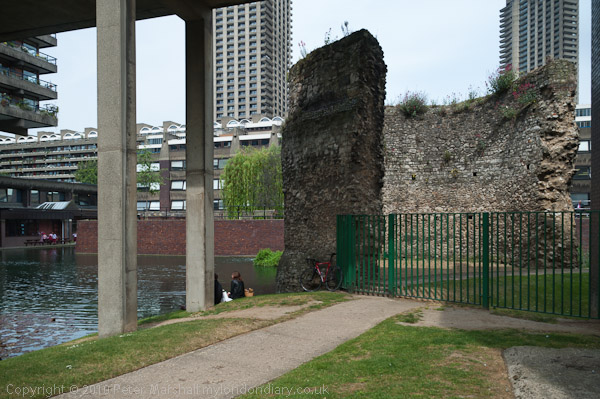
Lunchtime in the Barbican
more pictures
Rowland Hill spent several years proposing a reform of the British postal system, and eventually suceeded in getting approval for his penny post system and on May 6th 1840, the world's first adhesive postage stamp, the Penny Black went on sale, followed days later by the Tuppence Blue. I photographed his statue to mark the anniversary and we then continued to Postman's Park across the road, where as usual we stopped to read the memorial plaques inaugurated by GF Watts to ordinary people who died performing heroic acts. One more has appeared since I last looked at them carefully, very much in the style of the Victorian originals, recording Leigh Pitt's death saving a drowning boy from the canal at Thamesmead in 2007.
We continued on a tour of several other London gardens, including some that
many walk by without noticing. I was surprised to find in one of the a sculptural
group about the print, with a printer, editor and newsboy that I had last
seen some years ago not far from Fleet St.
more pictures
Photographers' City Hall Flashmob
City Hall, More London. Tuesday 3 May 2011
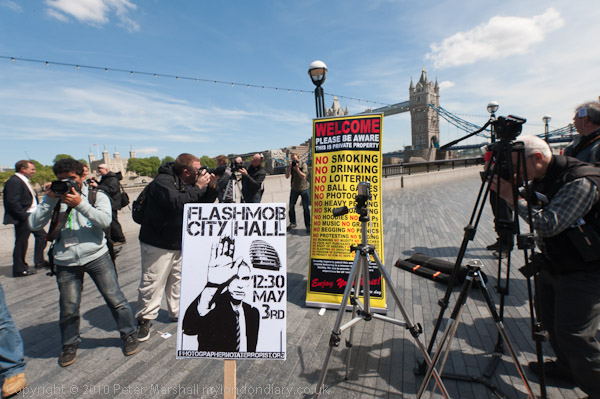
Photographers protest against photo ban in private public places
more pictures
On World Press Freedom day photographers held a flash mob protest outside City Hall calling for an end to the growing restrictions on photography in areas normally open to the public, delivering a letter for Mayor Boris Johnson.
The protest was called by 'I’m a Photographer, Not a Terrorist!' (PHNAT), "the campaign group set up to fight unnecessary and draconian restrictions against individuals taking photographs in public spaces" and supported by the NUJ London Photographers Branch, the British Press Photographers Association (BPPA) and the Campaign for Press and Broadcasting Freedom. It attracted many of the photographers who work daily on the streets of London.
Around 50 photographers came to the event, although getting all of them in a picture at the same time proved impossible, as whenever a group formed for a picture they were faced by a scrum of photographers taking it. Some of them had brought tripods, even though like me they may have had to spend a while searching for one.
Grant Smith, who made headlines after being stopped and searched for photographing St Paul's Cathedral, and whose image of a security guard holding up a hand to prevent him taking pictures was used on the mini-placard for the event, read out a letter to Mayor Boris Johnson from PHNAT, which as well as expressing concern at the increasing and often illegal activities of security guards also depreciated the role of the police in encouraging them to harass photographers. It ended:
"We are bringing this issue to the attention of the general public to highlight the creeping restrictions to press freedom and the right of the citizen to photograph in a public place."
A group of photographers then took the letter in to City Hall.
Security guards for the area were unusually thin on the ground during the protest, though one did walk up to the group and scratch his head while reading the banner which suggested a number of activities including photography or persons that are or might be banned beacuse this was private property. In part ironic, too much was unfortunately true.
In a statement I made about the protest to a photographer/reporter for Al-Jazeera I said:
Huge areas of London which the public walks through and enjoys are being turned into "no go" areas for photographers, patrolled by security guards and under continous observation by CCTV cameras. Almost every new development built in the past twenty or thirty years is now a private public space where we are now often stopped from taking photographs. It is a restriction on our freedom of speech and action and on the reporting of events, and one without sensible justification, largely based on a misplaced paranoia.
I've been prevented from taking pictures or hassled by security many times over the years, but the areas involved have now expanded greatly and there is now much greater surveillance, and photographers need to take action. I fully support this protest on World Press Freedom Day. The public need to reclaim these city public spaces and their right to enjoy them - including the right to take photographs.
Among the better-known places were such restrictions apply are the whole Canary Wharf estate (where I've been stopped on several occasions), Broadgate (ditto), Paddington Basin, and the site chosen for this protest, More London and the Thames Walkway along its river frontage, as well as many more smaller sites around the city. If the buildings around you were built in the last 20 or 30 years and you are in a pedestrianised area, there is a very high chance that you may be asked to stop photographing.
Many of the plans for these developments were granted on the understanding that the public would have access to and through them, and in many cases they include areas that were formerly public highways. The owners of these sites depend on public access to them for their commercial success, with many having shops and other commercial premises open to the public as well as offices. Yet they often try and prevent legitimate reporting related to public events on the grounds that it is private land.
Even the Mayor of London has in the past tried to restrict news photography, for example in Trafalgar Square, where heritage wardens have harassed some photographers. Last year I and other photographers were approached while photographing several protests in Royal Parks and told that we needed a licence to take pictures there, although that may have simply been a few ill-trained and badly informed employees, as on further enquiries the need seemed to evaporate.
There is of course a difference between commercial photography and news/reportage or fine art photography, but it is one that is largely self-policing. A commercial image that made more than incidental use of a building or location would generally now be required to have a building licence - in the same way as a model release would be needed for an identifiable person in it. Neither is a legal requirement, but both act as a protection against possible legal actions that could prevent or delay the use of the image.
As PHNAT was formed to point out, we are photographers, not terrorists. No terrorist is going to walk around with large cameras or even tripods to openly photograph sites they wish to attack. Almost certainly all the information they require is available on the web from satellite imagery and Google Streetview, and if they needed to add to that, a discreet walk around with a mobile phone or miniature camcorder seems considerably less likely to escape detection.
What we are seeing is an innapropriate and at times illegal assertion of
property rights (often security guards also try to prevent photography from
public land) and it is possibly unenforcable as there is generally no element
of financial loss to the owners. Next will they try to ban us from breathing
"their" air?
more pictures
Rochester Sweeps Festival
Rochester, Kent. Monday 2 May 2011
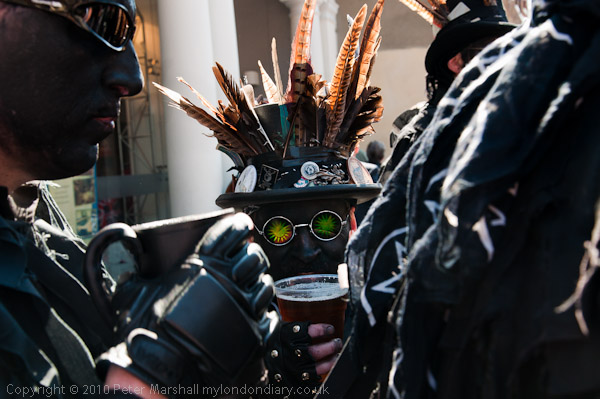
Hunters Moon Morris from Eastbourne; dancers blacked up to hide their identity
when dancing could get you blacklisted or worse.
more pictures
Rochester Sweeps' Festival is another May festival and was started in 1981, but claims to derive from a tradition dating back more than 400 years, when child chimney sweeps had one day off in the year and would come into town to make the most of it. And while traditional celebrations of May day were accompanied by all sorts of mischief and mayhem (no connection to May) that got maypoles banned by the puritans. In the past people might not have talked about phallic symbols, but I think there is little doubt what the maypole was about.
The Sweep's Festival aims to be a celebration of the traditional, with folk music, morris dancers and a green man as well as sweeps, and runs from Friday evening to Bank Holiday Monday afternoon, ending with a procession around the town. But what seems to be entirely missing are the kind of drunked orgies that used to mark the spring festival. Or perhaps I was just in the wrong place?
I'm told it's best to see it on Saturday or Sunday, but I had other things
to do, and in any case wanted to see the final procession. What I hadn't realised
was that relatively few of the dancers stay on for the final day, and although
the procession was interesting, it was considerably smaller than I expected.
more pictures
London May Day March
Clerkenwell Green. Sunday 1 May 2011
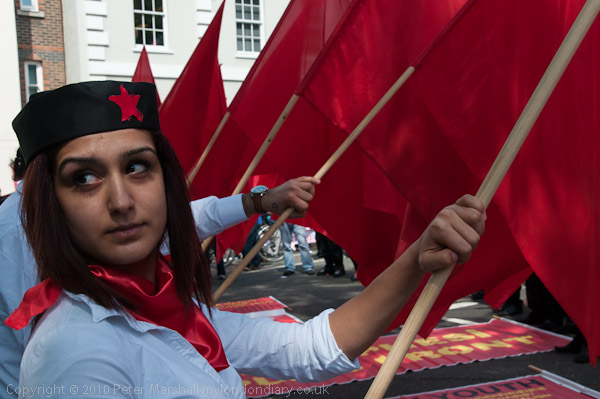
As usual, the Turkish communists put on a fine display
more pictures
May Day has been celebrated in London since the 1880s as a socialist festival of international solidarity with people across the world. The annual march is organised by the London May Day Organising Committee and brings together trade unionists, workers from the many international communities in London, pensioners, anti-globalisation organisations, students, political bodies and many others in a show of working class unity.
The marchers gathered at Clerkenwell Green, a traditional meeting place for the labour movement at least since the Peasant's Revolt of 1381, and the starting point for London's first May Day March in 1890. Before the march there were various activities by the different groups around the square including a number of speeches and some dancing.
The march started at 1pm, led by an band of Musicians Union members, and the first part of the march was mainly trade union groups. As in previous years there was a very strong representation of nationalist communist groups from London's Turkish, Kurdish and Cypriot communities as well as a large group of Sri Lankan Tamils calling for the war criminals from Sri Lanka to be taken to the International Criminal Court and asking why the UN and NATO had not intervened when their community in Sri Lanka was facing massacre.
A new group in this year's march was 'Justice for Domestic Workers' (J4DW), a self-help group for migrant domestic workers and part of the hotel, restaurant and catering branch of the Unite the union. They were using the event to launch a new petition urging the UK government to change its position and endorse the ILO convention.
At the end of the march there was a rally in Trafalgar Square where around
10,000 gathered in a peaceful protest against the cuts in public services
and calling for a general strike. I went home instead.
more pictures
top of page
All pictures on this section of the site are Copyright © Peter Marshall 2011; to buy prints or for permission to reproduce pictures or to comment on this site, or for any other questions, contact me.

